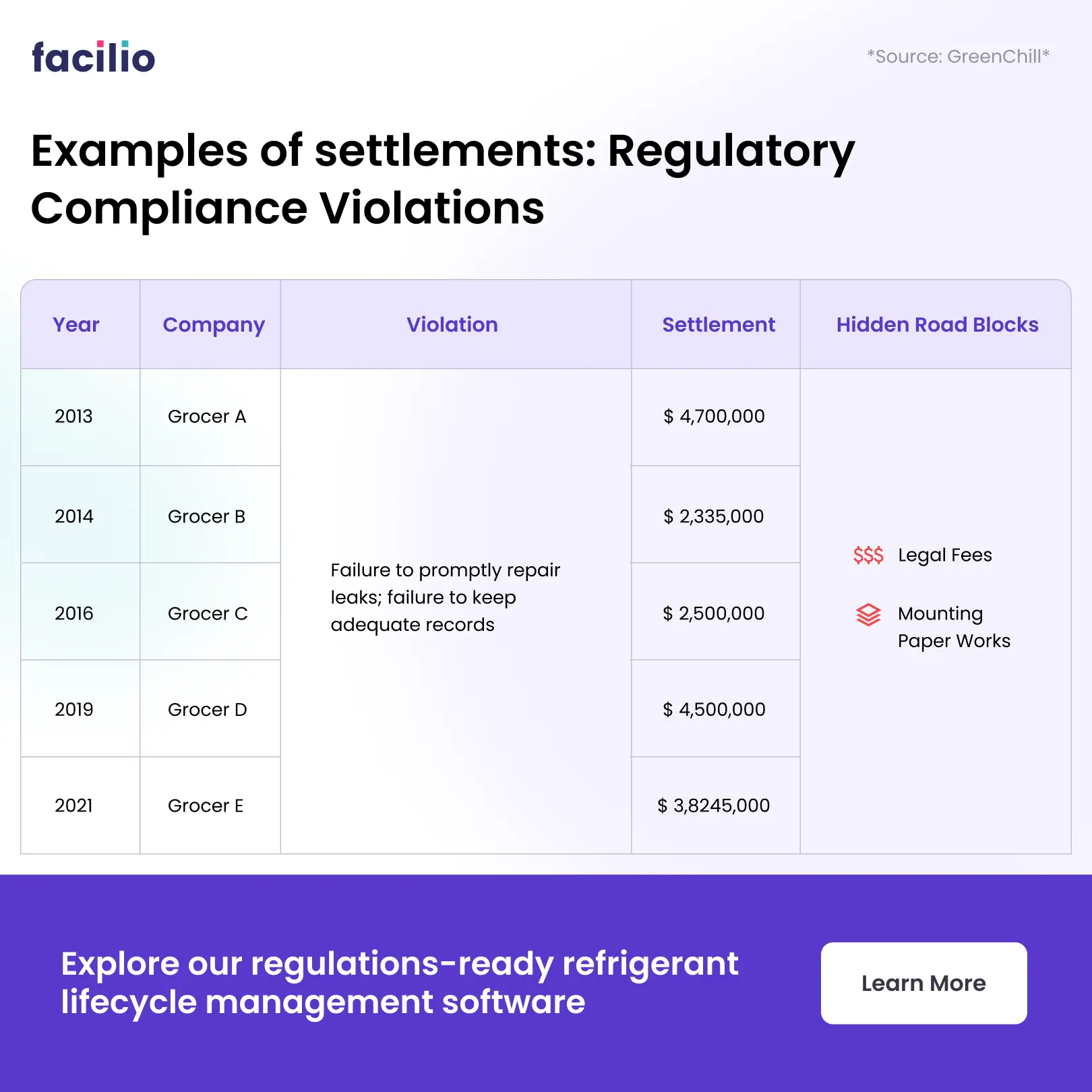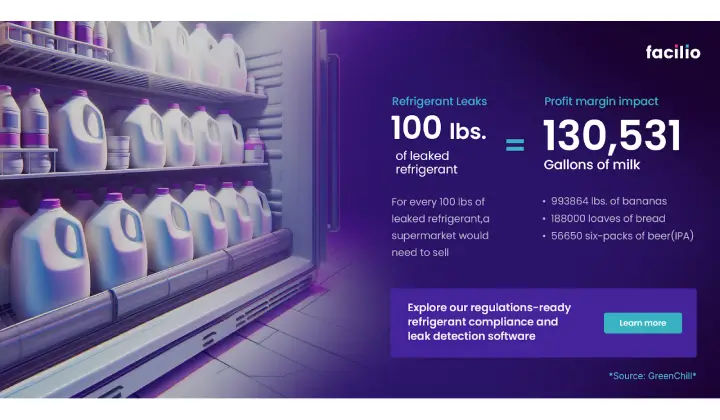Refrigeration Monitoring
Refrigerant Leak Detection: Methods of Detection and Regulatory Requirements
If a refrigerant leak went undetected, you would experience equipment breakdowns, energy losses, and possibly be charged up to $37,500 in daily fines for non-compliance with EPA (Environmental Protection Agency) refrigerant management and reporting.
The EPA 608 regulations require prompt repair of refrigerant leaks. Failure to do so attracts huge fines.
In this article, you’ll learn:
- The importance of refrigerant leak detection
- The tools and methods for detecting refrigerant leaks
- EPA refrigerant leakage and detection repair requirements
- How Facilio saves you hefty compliance fines
Let’s get started.
What is the importance of refrigerant leak detection?
The consequences of a refrigerant leak are disastrous. In addition to the leaking chemicals that can damage the earth’s ozone layer, there are other burdens to consider.
Prevents additional costs
Picture this: your cooling system has a tiny, unnoticed leak. It might not seem like a big deal at first, but over time, that leak can grow, causing your system to work harder to maintain the same temperature. This translates to higher energy bills.
With a refrigerant leak detection system, you could prevent a tiny leak from growing, saving yourself extra costs.
Avoids frequent compressor breakdowns
A compressor is the heart of your cooling system. When there's a leak, your compressor must work overtime to keep your devices cool. This causes extra strain on the compressor, which can lead to more frequent breakdowns.
Prevents frequent unplanned downtime
You find yourself shelling out more and more money for repairs with a broken compressor and leaking refrigerant. This causes downtime for restaurants or retail facilities that rely heavily on refrigeration systems.
Food spoils, tempers flare, and sales take a nosedive.
Ensures adherence to regulatory requirements
Certain regulatory requirements are put in place to protect our environment and health, enforced by the EPA, the AIM Act (American Innovation and Manufacturing Act), and the Clean Air Act. These agencies cover various environmental issues, including air quality, emissions reduction, and hazardous waste management.

Read More:
- EPA Refrigerant Regulations: Elevate EPA 608 & Compliance Readiness
- Refrigerant Compliance Management Software in 2024
The EPA mandates that refrigeration facilities promptly repair leaks to minimize environmental impact. We’ll discuss other regulatory requirements in detail later in this article.
For now, let’s explore some methods for detecting refrigerant leaks.
Tools and Methods for Detecting Refrigerant Leaks
There are two major methods for detecting refrigerant leaks: the traditional and the electronic leak detection methods.
Traditional methods
- Soap bubble method: This is the cheapest method of detecting refrigerant leaks. It involves applying a soap solution to potential leak points and watching for bubbles. If there are any leaks, bubbles will appear.
- Ultraviolet method: This is otherwise known as the fluorescent dye method. A UV dye is introduced into the system and circulates within the refrigerant. If there is a leak, the dye escapes through the leak. When exposed to refrigerant, the dye becomes visible under UV light.
- Nitrogen detection method: This involves pressurizing the system with nitrogen. Firstly, the system is evacuated of refrigerant, ensuring no interference from the existing gas. Then, nitrogen is pumped into the system, pressurizing it. If there's a leak, a sound will be audible.
Electronic leak detection methods
- Heated diode: The heated diode detector sniffs out refrigerant leaks by heating the gas and sensing any changes in electrical resistance. It produces an alarm when a leak is detected, making it quick, efficient, and sensitive.
- Ultrasonic: It listens for the high-frequency sound emitted by leaking refrigerants, helping you track down elusive leaks—even in noisy environments.
- Infrared detector: The infrared detector uses infrared sensors to detect the presence of refrigerant gases. If there’s a leak, the refrigerant will absorb the infrared.
In the retail industry, automatic leak detection (ALD) systems are used at the store level to detect leaks, issue notifications, and continuously monitor and report any anomalies.
However, the sensors and controllers of these systems raise alarms, without context, whenever the set points are breached. For instance, refrigeration systems work harder during restocking or peak retail store hours to maintain the desired temperatures.
However, the sensors and controllers are unable to understand the difference between such situations and malfunctioning refrigerators—and raise unnecessary alarms.

Facilio’s intelligent IoT–and AI-based Connected Refrigeration Software makes refrigeration systems smarter by understanding the context behind sensor data and automating relevant action at the portfolio level. It is a ready-to-deploy meant for retail store owners who want to implement automatic leak detection systems to detect and fix refrigerant leaks and ensure 100% compliance. With the EPA tightening regulations around permissible leak volumes, it’s necessary to have an intelligent remote monitoring system that helps you stay compliant across multi-site operations.
EPA Refrigeration Leak Repair Requirements
As an operator or business owner, you’ve probably heard about the revised EPA regulations that start January 1, 2025.
The EPA’s Refrigeration Leak Repair Requirements aim to reduce the emissions of ozone-depleting substances (ODS) and greenhouse gases (GHGs) from refrigeration and air conditioning systems.
These EPA requirements aim to minimize the environmental impact of refrigerant leaks.
The regulations state that you must take corrective action when an appliance with a full charge of 50 or more pounds is discovered to be leaking ozone-depleting refrigerant at a rate that exceeds the applicable trigger rate.
Commercial Refrigeration: Systems with over 50 pounds of refrigerant must repair leaks at a 20% annual leak rate.
Industrial Process Refrigeration (IPR): Systems require repairs at a 30% annual leak rate.
Comfort Cooling Systems (HVAC): Must address leaks at a 10% annual rate.
Failure to comply with these regulations will result in penalties for non-compliance and potentially significant fines if not addressed proactively.
Although the revised regulations include stricter regulations and lower leak thresholds, there’s a way around them—by applying preventative measures.
These preventive measures can save you hefty fines when you leverage real-time leak detection and automated reporting technology.
How Facilio Saves You Hefty Compliance Fines
Facilio’s advanced refrigerant compliance and leak detection software protects your retail business from penalties with automated refrigerant inspections and real-time leak detection.

To replace 100 tons of refrigerant leaks, you would have to sell 130,531 gallons of milk, which is approximately $11,500. Failure to promptly repair leaks and keep adequate records can create mounting legal fees and paperwork with a settlement of as high as $38,245,000.
Facilio’s single-pane-of-glass solution offers the following advantages over legacy leak detection systems:
Condition-based & proactive detection
IoT-enabled sensors provide real-time insights into key performance indicators, such as energy consumption, air quality, and equipment status. You can identify context-based deviations from compliance standards and fix issues before they escalate.
Automated inspections
You can automate routine inspections, and manage inventory more efficiently across multiple sites by monitoring usage history and price information.
Automated audits & enhanced compliance
You can generate accurate reports for leak rates, refrigerant inventory levels, periodic inspections, etc to build audit records across your portfolio. In addition, you can consolidate HVACR data and reports from individual systems and sources to adhere to US and EU climate control regulations.
You can also ensure compliance by actively monitoring asset lifecycles, maintenance SLAs, and other factors.
So, what are you waiting for? Book a demo to get started.
Frequently Asked Questions
- What is the best refrigerant leak detection method?
The best refrigerant leakage detection method depends on various factors such as sensitivity, accuracy, ease of use, and cost-effectiveness. Traditional methods are commonly used, but they may need more precision. Electronic leak detection methods offer greater sensitivity and efficiency. The choice ultimately depends on your facility's specific needs and resources.
2. What is the most reliable leak detection method, and why?
Electronic refrigerant leakage detection methods are generally considered the most reliable due to their high sensitivity and accuracy.
3. What are the requirements for refrigerant leak detection?
Refrigerant leakage detection requirements vary depending on regulatory standards and industry best practices. Generally, facilities are mandated to implement leak detection systems to comply with environmental regulations outlined by the EPA, AIM, and Clean Air Act.
4. What is the preferred method of air conditioning system leak detection?
Electronic leak detection methods are commonly favored for detecting leaks accurately and efficiently in large HVAC systems. These methods offer real-time monitoring capabilities and integrate seamlessly with facility management systems like Facilio. By leveraging advanced technology and seamless integration, Facilio enhances the effectiveness of leak detection, enabling proactive maintenance and energy savings.


